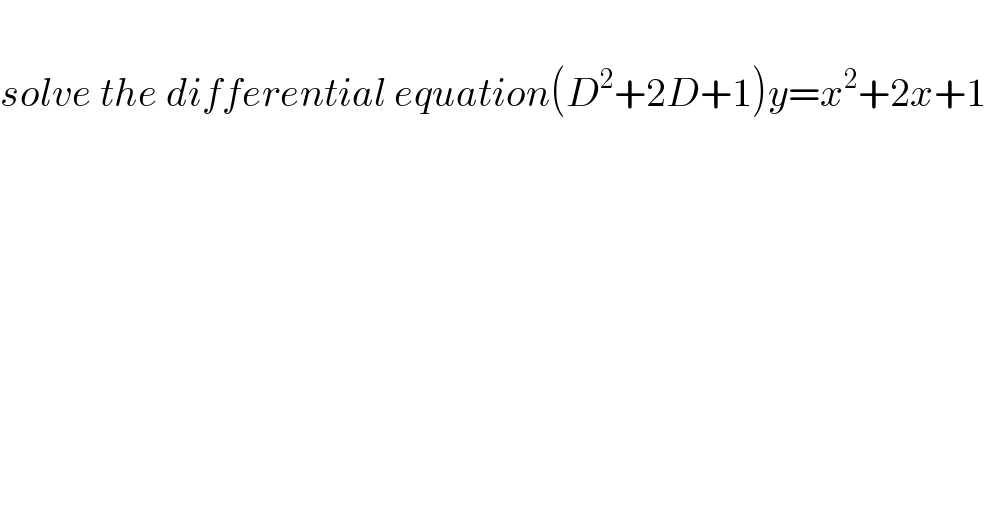
Question Number 26073 by gopikrishnan005@gmail.com last updated on 19/Dec/17

$$ \\ $$$${solve}\:{the}\:{differential}\:{equation}\left({D}^{\mathrm{2}} +\mathrm{2}{D}+\mathrm{1}\right){y}={x}^{\mathrm{2}} +\mathrm{2}{x}+\mathrm{1} \\ $$
Commented by gopikrishnan005@gmail.com last updated on 20/Dec/17

$${pls}\:{explain} \\ $$
Commented by abdo imad last updated on 21/Dec/17

$$\Leftrightarrow\:\:\frac{{d}^{\mathrm{2}} {y}}{{dx}^{\mathrm{2}} }\:\:+\mathrm{2}\frac{{dy}}{{dx}}\:\:+{y}\:={x}^{\mathrm{2}} +\mathrm{2}{x}+\mathrm{1}\:\:{the}\:{solution}\:{of}\:{this}\:{ED}\:{is} \\ $$$${y}_{{g}} \:\:=\:{y}_{{h}} \:+{y}_{{p}} \:\:..\:{y}_{{h}} \:\:{is}\:{the}\:{homogen}\:{s}^{{t}} \:\:{and}\:{y}_{{p}} \:\:{particular}\:{s}^{{t}} \\ $$$${EH}−−>\:\frac{{d}^{\mathrm{2}} {y}}{{dx}^{\mathrm{2}} }\:+\:\mathrm{2}\frac{{dy}}{{dx}}\:\:+\mathrm{1}\:=\mathrm{0}\:{have}\:{the}\:{caracteristic}\:{equation} \\ $$$${x}^{\mathrm{2}} \:+\mathrm{2}{x}\:+\mathrm{1}=\mathrm{0}\Leftrightarrow\:\:\left({x}+\mathrm{1}\right)^{\mathrm{2}} =\mathrm{0}\Leftrightarrow\:{x}=−\mathrm{1}\Rightarrow\:\:{y}_{{h}} \:\:=\left(\alpha{x}+\beta\right){e}^{−{x}} \:\left(−\mathrm{1}\:{is}\:{double}\:{root}\right) \\ $$$${for}\:{y}_{{p}} \:\:{we}\:{put}\:{y}={ax}^{\mathrm{4}} \:+{bx}^{\mathrm{3}} \:+{cx}^{\mathrm{2}} \:+{dx}\:+{e}\Rightarrow \\ $$$$\frac{{dy}}{{dx}}=\:\mathrm{4}{ax}^{\mathrm{3}} +\:\mathrm{3}{bx}^{\mathrm{2}} \:+\mathrm{2}{cx}\:+{d}\:\:{and}\:\:\frac{{d}^{\mathrm{2}} {y}}{{dx}^{\mathrm{2}} }\:\:=\:\mathrm{12}{ax}^{\mathrm{2}} +\mathrm{6}{bx}\:+\mathrm{2}{c} \\ $$$${we}\:{find}\:{after}\:{calculus}\:\:{a}=\mathrm{0}..{b}=\mathrm{0}...{c}=\mathrm{1}..{d}=−\mathrm{2}...{e}=\mathrm{3} \\ $$$${and}\:{y}_{{g}} \:\:=\left(\alpha{x}+\beta\right){e}^{−{x}} \:\:+{x}^{\mathrm{2}} \:−\mathrm{2}{x}\:+\mathrm{3}\:\:. \\ $$
